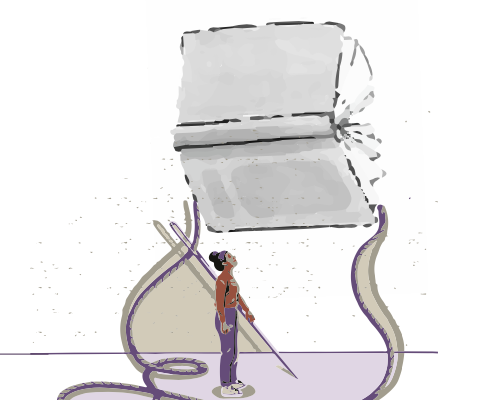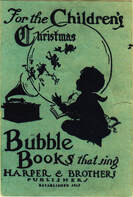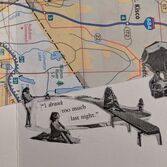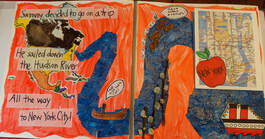Feminist Philosophical Toys
|
Collaborative pedagogical research project with Nassim Parvin.
Series of 8 interactive DIY paper toys for teaching feminist philosophy to Design students. Disucssed in:
|
When You Hear the Chime
|
Audio soundtrack to accompany listen-and-look format miniature book on history of intermedial storytelling with sound. Full paper forthcoming in ICIDS 2022 proceedings, co-authored with Lissa Holloway-Attaway.
Downloadable cut-and-fold illustrated mini book
| |||||||
Paperology: an ephemeral portrait
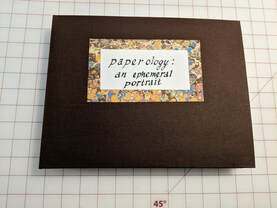
Handmade Artist Book, 2020
Design + Paper Engineering: Rebecca Rouse
Artefact Lab and -Atelier 30- in the Department of Communication @ Université de Montréal present:
The Paperology Reading and Activity Group, Organized by:
❧ Juliette De Maeyer, Associate Professor
❧ Aleksandra Kaminska, Assistant Professor
❧ Alysse Kushinski, Postdoctoral Researcher
❧ Ghislain Thibault, Associate Professor
The Paperology Reading and Activity Group takes place during the 2020-2021 academic year. While the most common of everyday materials, paper has received less critical attention than it deserves. The objective for this group is to engage with the emerging research and growing literature on paper as material. In working towards an expansive approach to paper, we are less invested in what is on the page than we are in the page itself (Stamm, 2018). Instead, we want to better understand the material histories, forms, practices, and possibilities of paper. Paper has been of interest to artists, art historians, and book historians, but it has been surprisingly under examined as media and technology from the broader perspective of fields such as media and communication studies.
Paperology: An Ephemeral Portrait is a handmade, cloth-bound artist book that will function as a substrate for interaction, inscription, annotation, and collaboratively created artworks from the participants in the Paperology group. Shipped around the globe to participants among the 75-member group, as the book object collects contributions it will become a co-created / co-authored snapshot documentation of the group in process, similar to the Victorian commonplace book or scrapbook traditions.
Opening the book, the left side is comprised of a long, accordion fold panorama. Each panel of the accordion has a small, blue, hand-made envelope that contains a different type of paper sample inside. Samples range from handmade papers, to commercially made artist papers, to industrial paper such as deli paper and kraft paper, even a sample of a polypropylene based paper. Each envelope is labeled with the type of paper contained inside. The right side of the book contains three objects: two miniature books (one small and one tiny), and a handmade paper map folded "pocket map" style with boards of thick card at each end.
The page of the accordion that holds the kraft paper sample also holds my artist dedication to the group, written on brown paper:
To My Fellow Paperologists:
Thank you for extending fibres of connection in such a fraught time. I hope you will bring that same spirit of generous and generative creatvitity to this material text.
-Rebecca Rouse, Skövde, Sweden - December 2020
Follow the progress of Paperology: An Ephemeral Portrait as it travels the globe reaching new co-authors: https://paperologybook.nfshost.com/
Design + Paper Engineering: Rebecca Rouse
Artefact Lab and -Atelier 30- in the Department of Communication @ Université de Montréal present:
The Paperology Reading and Activity Group, Organized by:
❧ Juliette De Maeyer, Associate Professor
❧ Aleksandra Kaminska, Assistant Professor
❧ Alysse Kushinski, Postdoctoral Researcher
❧ Ghislain Thibault, Associate Professor
The Paperology Reading and Activity Group takes place during the 2020-2021 academic year. While the most common of everyday materials, paper has received less critical attention than it deserves. The objective for this group is to engage with the emerging research and growing literature on paper as material. In working towards an expansive approach to paper, we are less invested in what is on the page than we are in the page itself (Stamm, 2018). Instead, we want to better understand the material histories, forms, practices, and possibilities of paper. Paper has been of interest to artists, art historians, and book historians, but it has been surprisingly under examined as media and technology from the broader perspective of fields such as media and communication studies.
Paperology: An Ephemeral Portrait is a handmade, cloth-bound artist book that will function as a substrate for interaction, inscription, annotation, and collaboratively created artworks from the participants in the Paperology group. Shipped around the globe to participants among the 75-member group, as the book object collects contributions it will become a co-created / co-authored snapshot documentation of the group in process, similar to the Victorian commonplace book or scrapbook traditions.
Opening the book, the left side is comprised of a long, accordion fold panorama. Each panel of the accordion has a small, blue, hand-made envelope that contains a different type of paper sample inside. Samples range from handmade papers, to commercially made artist papers, to industrial paper such as deli paper and kraft paper, even a sample of a polypropylene based paper. Each envelope is labeled with the type of paper contained inside. The right side of the book contains three objects: two miniature books (one small and one tiny), and a handmade paper map folded "pocket map" style with boards of thick card at each end.
The page of the accordion that holds the kraft paper sample also holds my artist dedication to the group, written on brown paper:
To My Fellow Paperologists:
Thank you for extending fibres of connection in such a fraught time. I hope you will bring that same spirit of generous and generative creatvitity to this material text.
-Rebecca Rouse, Skövde, Sweden - December 2020
Follow the progress of Paperology: An Ephemeral Portrait as it travels the globe reaching new co-authors: https://paperologybook.nfshost.com/
Simmer
|
Handmade AR Artist Book, 2019
Design + Paper Engineering: Rebecca Rouse Text + Augmented Reality: Lissa Holloway-Attaway Music: Brendan Padgett November 20-22, ICIDS International Conference for Interactive Digital Storytelling Juried Art Exhibition, Salt Lake City, Utah *Winner, ICIDS Art Exhibition Excellence in Innovation Award |
Book Trailer for Simmer (2019)
Page-through documentation of Simmer (2019)
Simmer is entirely handmade two-sided artist book and AR (augmented reality) application that explores and expands John Cheever's classic short story, "The Swimmer" (1964). While Cheever's landmark story crafts an expert portrayal of its protagonist, narcissistic Ned Merrill, Ned's wife (Lucinda) and four unnamed daughters are left unexplored. While this narrow focus is appropriate for Cheever's text, this absence can also be an invitation to explore the ways in which the emotional violence and pain wrought by a narcissistic person (Ned) resonates through the family. This is the focus of Simmer.
The first side of Simmer opens as a linear accordion fold book and presents a re-telling of Ned's story, Collage elements begin as more naturalistic representations at the left of the panorama, but transition to more surreal as the reader progresses. Cutup quotations from Cheever's original text are woven into the imagery, often filling the empty swimming pools that dot the landscape. A red thread is sewn through the book, drawing suggestive connections between houses and people in the Westchester county suburb, all lounging in a seemingly eternal cocktail hour, poolside.
Each two-page spread of the accordion panorama acts as a trigger image for the accompanying AR app, calling up atmospheric music and voiced dialogue. Characters in Ned's world react to his passage across the page, welcoming him, offering him drinks, and threatening to reveal dark secrets. A chill bossa nova soundtrack becomes more pensive as the reader moves across the pages.
Turning the book inside out, a dollhouse structure emerges. The nonlinear narrative of the house space is pieced together through the reader's exploration, by manipulating a variety of traditional pop-up and movable elements (paper dolls, animated flip book, miniature book, tunnel book, flaps, fold-out map painted with thermo-chromic paint that responds to heat, revealing hidden text when touched by the reader.) Each of these elements is also tracked by the AR app to reveal audio, this time voiced by Lucinda, Ned's wife, as she tells her side of the story. Miniature LPs play musical themes for the female characters, deconstructed and introspective inversions of the cheery music from the pool party side of the book.
The red thread sewn through the other side of the book emerges in the house through Lucinda's writing desk, as the thread in the hand-sewn binding of a miniature book of poetry. As Lucinda's experience is revealed, we learn the devastating impact Ned's narcissism has had on her and the family. Lucinda is complex, however, and far from powerless, revealing dark secrets of her own as well. What simmers bubbles up, and invites the reader to explore the raw edges of humanity within us all.
The first side of Simmer opens as a linear accordion fold book and presents a re-telling of Ned's story, Collage elements begin as more naturalistic representations at the left of the panorama, but transition to more surreal as the reader progresses. Cutup quotations from Cheever's original text are woven into the imagery, often filling the empty swimming pools that dot the landscape. A red thread is sewn through the book, drawing suggestive connections between houses and people in the Westchester county suburb, all lounging in a seemingly eternal cocktail hour, poolside.
Each two-page spread of the accordion panorama acts as a trigger image for the accompanying AR app, calling up atmospheric music and voiced dialogue. Characters in Ned's world react to his passage across the page, welcoming him, offering him drinks, and threatening to reveal dark secrets. A chill bossa nova soundtrack becomes more pensive as the reader moves across the pages.
Turning the book inside out, a dollhouse structure emerges. The nonlinear narrative of the house space is pieced together through the reader's exploration, by manipulating a variety of traditional pop-up and movable elements (paper dolls, animated flip book, miniature book, tunnel book, flaps, fold-out map painted with thermo-chromic paint that responds to heat, revealing hidden text when touched by the reader.) Each of these elements is also tracked by the AR app to reveal audio, this time voiced by Lucinda, Ned's wife, as she tells her side of the story. Miniature LPs play musical themes for the female characters, deconstructed and introspective inversions of the cheery music from the pool party side of the book.
The red thread sewn through the other side of the book emerges in the house through Lucinda's writing desk, as the thread in the hand-sewn binding of a miniature book of poetry. As Lucinda's experience is revealed, we learn the devastating impact Ned's narcissism has had on her and the family. Lucinda is complex, however, and far from powerless, revealing dark secrets of her own as well. What simmers bubbles up, and invites the reader to explore the raw edges of humanity within us all.
The Golden Key Variations
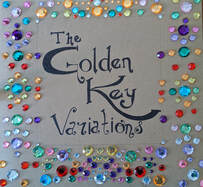
Handmade Mixed Media Pop-Up Book, 2019
Author, Illustrator, and Paper Engineer: Rebecca Rouse
Music: Brendan Padgett
May 22 - June 2, Changing Climates exhibition
Karlskrona Marine Museum, Karlskrona, Sweden
What new fairy tales will be written in the coming era of Climate Change? Taking inspiration from the Grimm Brothers' story The Golden Key, which has a unique narrative structure with an open ending that calls out to the reader to participate in imagining the final scene on their own, The Golden Key Variations traces the influence of the Grimm tale across three classic stories (Alice in Wonderland by Lewis Carroll, The Secret Garden by Frances Hodgson Burnett, and The Golden Key by George Macdonald). The book then shifts to imagine four new fairy tales from the speculative future, set in a post-Climate Migration world.
A set of characters navigate the new challenges in this coming world including rising sea levels, deforestation, toxic algae, extinction, and political apathy. The figure of the golden key acts as an enigmatic metaphor, wielded with wisdom by children, but less well used by adult characters. The book ends with a message of hope for our future, suggesting we look for inspiration to children such as Greta Thunberg, Swedish Climate Activist. On another level, the book invites us to reflect on the meaning of participation and interactivity in the reading experience in our digital age, and builds on the centuries-long history of movable book design.
Interactive elements in The Golden Key Variations include traditionally paper engineered movable book flaps, pockets, fold-outs, and 3D pop-ups, as well as a peep show, flip book, thaumatrope, and embedded musical sound chip.
Special thanks to Sandra Rouse, for sharing her white line woodblock test prints for The Secret Garden pages. Thanks also to Moa Andersson and Jefferson Keilwagen for their kind help and feedback.
Author, Illustrator, and Paper Engineer: Rebecca Rouse
Music: Brendan Padgett
May 22 - June 2, Changing Climates exhibition
Karlskrona Marine Museum, Karlskrona, Sweden
What new fairy tales will be written in the coming era of Climate Change? Taking inspiration from the Grimm Brothers' story The Golden Key, which has a unique narrative structure with an open ending that calls out to the reader to participate in imagining the final scene on their own, The Golden Key Variations traces the influence of the Grimm tale across three classic stories (Alice in Wonderland by Lewis Carroll, The Secret Garden by Frances Hodgson Burnett, and The Golden Key by George Macdonald). The book then shifts to imagine four new fairy tales from the speculative future, set in a post-Climate Migration world.
A set of characters navigate the new challenges in this coming world including rising sea levels, deforestation, toxic algae, extinction, and political apathy. The figure of the golden key acts as an enigmatic metaphor, wielded with wisdom by children, but less well used by adult characters. The book ends with a message of hope for our future, suggesting we look for inspiration to children such as Greta Thunberg, Swedish Climate Activist. On another level, the book invites us to reflect on the meaning of participation and interactivity in the reading experience in our digital age, and builds on the centuries-long history of movable book design.
Interactive elements in The Golden Key Variations include traditionally paper engineered movable book flaps, pockets, fold-outs, and 3D pop-ups, as well as a peep show, flip book, thaumatrope, and embedded musical sound chip.
Special thanks to Sandra Rouse, for sharing her white line woodblock test prints for The Secret Garden pages. Thanks also to Moa Andersson and Jefferson Keilwagen for their kind help and feedback.
Around the World With Swimmy Apple
This handmade interactive book was created in collaboration with the twenty-one 3 - 5 year-old students of Erin Mergil and Jessica Pelizari's classroom at the Woodland Hill Montessori School in East Greenbush, NY. The story tells the adventure of Swimmy Apple, the classroom's red beta fish, as he travels the globe. Swimmy's adventure showcases both the children's knowledge of world geography, botany, zoology, and artistic skills in drawing, watercoloring, and paper art as the beloved fish visits each of the seven continents, as well as an inter-textual romp through a selection of the children's favorite picture books.
In the first spread, Swimmy Apple appears in his fishbowl in the classroom, represented as a miniature plastic fish that can be removed and played with throughout the volume. He is depicted next to the classroom bookshelf, where the children's favorite picture books are displayed in miniature, as flaps that open to showcase key imagery from each book.
The next page has Swimmy leaving on his adventure, heading down the Hudson River to New York City and beyond. As Swimmy travels the globe, he meets friends old and new, before finally returning to the children's own classroom in upstate New York, with a doll-house pullout version of the classroom on the final pages. Throughout the book a wide range of paper engineering techniques are used, including flaps, pop-ups, enclosures, and even an embedded flip book, as well as an interactive sound chip on the final page, with a recording of the children themselves singing a 'welcome home' song to Swimmy Apple.
To make the book, teachers Erin and Jessa invited me into the classroom to teach a series of workshops on the history of movable books and how to make them to the children. The story of the book was developed collaboratively during these workshops, and in response to the children's ideas I first created a "blank" or prototype of the book. Then Erin and Jessa worked with the children to guide them in creating the original artwork for the book, which was carefully color-copied for use in the final volume.
The final artwork is a testament to Erin and Jessa's skill not only as teachers but as master collaborators, bringing together such a large group of participants with diverse ages and abilities, as well as stunning exemplar of the children's marvelous creativity, artistry and skill. The book was developed as a fundraising effort to raise money for the school at auction, where it was sold but then generously donated the back to the school, where it remains on display.
The image galleries below show the "blank" book prototype, as well as images of the final copy in progress, and at completion.
In the first spread, Swimmy Apple appears in his fishbowl in the classroom, represented as a miniature plastic fish that can be removed and played with throughout the volume. He is depicted next to the classroom bookshelf, where the children's favorite picture books are displayed in miniature, as flaps that open to showcase key imagery from each book.
The next page has Swimmy leaving on his adventure, heading down the Hudson River to New York City and beyond. As Swimmy travels the globe, he meets friends old and new, before finally returning to the children's own classroom in upstate New York, with a doll-house pullout version of the classroom on the final pages. Throughout the book a wide range of paper engineering techniques are used, including flaps, pop-ups, enclosures, and even an embedded flip book, as well as an interactive sound chip on the final page, with a recording of the children themselves singing a 'welcome home' song to Swimmy Apple.
To make the book, teachers Erin and Jessa invited me into the classroom to teach a series of workshops on the history of movable books and how to make them to the children. The story of the book was developed collaboratively during these workshops, and in response to the children's ideas I first created a "blank" or prototype of the book. Then Erin and Jessa worked with the children to guide them in creating the original artwork for the book, which was carefully color-copied for use in the final volume.
The final artwork is a testament to Erin and Jessa's skill not only as teachers but as master collaborators, bringing together such a large group of participants with diverse ages and abilities, as well as stunning exemplar of the children's marvelous creativity, artistry and skill. The book was developed as a fundraising effort to raise money for the school at auction, where it was sold but then generously donated the back to the school, where it remains on display.
The image galleries below show the "blank" book prototype, as well as images of the final copy in progress, and at completion.
- Image Gallery of book prototype
- Image gallery of final book in progress
